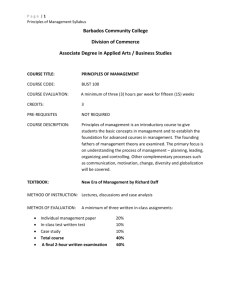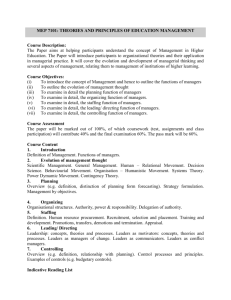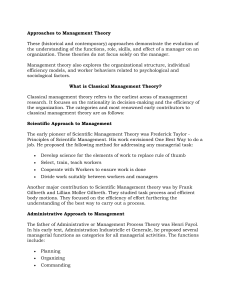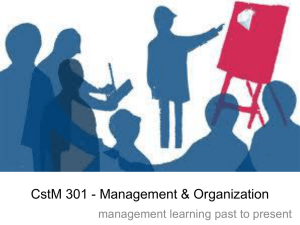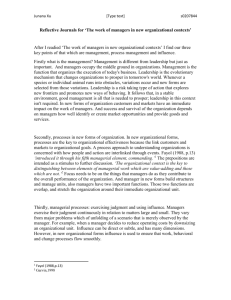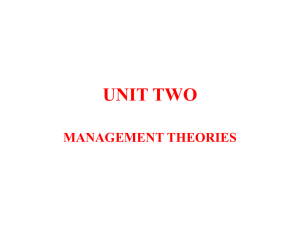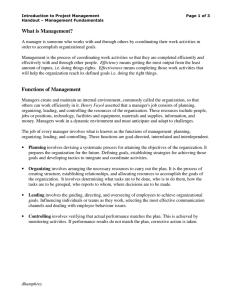HISTORY AND EVOLUTION OF MANAGEMENT
advertisement
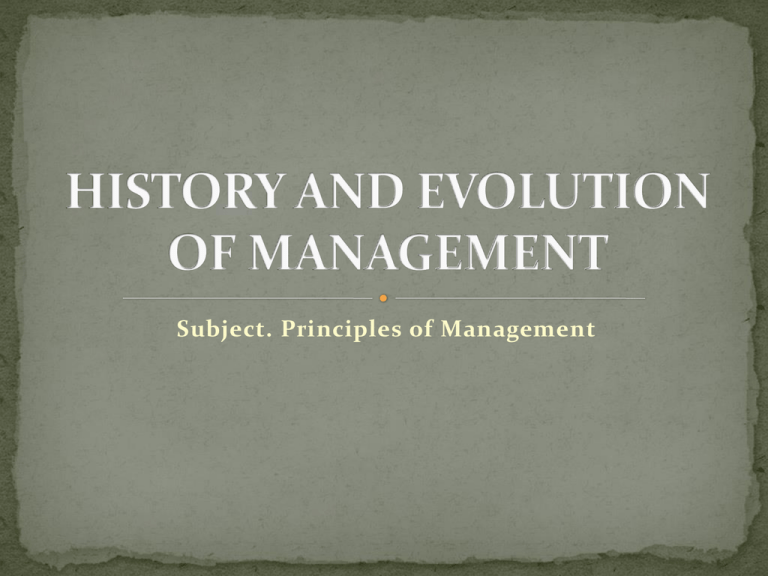
Subject. Principles of Management The verb manage comes from the Italian maneggiare (to handle — especially tools), which in turn derives from the Latin manus (hand). The French word mesnagement (later ménagement) influenced the development in meaning of the English word management in the 17th and 18th centuries. Some definitions of management are: Organization and coordination of the activities of an enterprise in accordance with certain policies and in achievement of clearly defined objectives. Management is often included as a factor of production along with machines, materials, and money. Mary Parker Follett (1868–1933), who wrote on the topic in the early twentieth century, defined management as "the art of getting things done through people". She also described management as philosophy. One can also think of management functionally, as the action of measuring a quantity on a regular basis and of adjusting some initial plan; or as the actions taken to reach one's intended goal. This applies even in situations where planning does not take place. From this perspective, Frenchman Henri Fayol considers management to consist of seven functions: 1. planning 2. organizing 3. leading 4. coordinating 5. controlling 6. staffing 7. motivating Some people, however, find this definition, while useful, far too narrow. The phrase "management is what managers do" occurs widely, suggesting the difficulty of defining management, the shifting nature of definitions, and the connection of managerial practices with the existence of a managerial cadre or class. An Early Prospective. The first known management ideas were recorded in 3000-4000 B.C. One Pyramid built by Egyptian ruler Cheops required work to be done by 100,000 men for over twenty years in 2900 B.C. It covered 13 acres of land and measured 481 meters in height. The stone slabs had to be moved thousands of kilometers of distance. As folklore goes, even the sound of a hammer was not heard in the villages in the vicinity of the site of these pyramids. Such monumental work could not be completed without adherence to principles of sound management. Rational economic view, scientific management, administrative principles, and bureaucratic organization characterize this phase. While the rational economic view assumed that people are motivated by economic gains primarily; scientific management of F.W. Taylor and others emphasized one best way of production etc; administrative theorists personified by Henri Fayol etc looked at the best way to combine jobs and people into an efficient organization; bureaucratic organization theorists led by Max Weber looked at ways to eliminate managerial inconsistencies due to abuse of power which contributed to ineffectiveness. This was the era of the industrial revolution and factory system of production. Large scale production would not have been possible without adherence to the principles governing organizing production based on division of labor and specialization, relationship between man and the machine, managing people and so on. This school of thought developed between 1920s to 1950s felt that employees simply do not respond rationally to rules, chains of authority and economic incentives alone but are also guided by social needs, drives and attitudes. Hawthorne Studies at GEC etc., were conducted then. It was quite natural that in the early phases of the industrial revolution, the emphasis was on development of techniques and technology. The attention to the human factor was the salient aspect of this school of thought. This attention was to serve as a precursor to the development of behavioral sciences. It sees modern organisations as complex systems and underlies contingency approach and use of modern techniques to solve organisational and human problems. The first comprehensive theories of management appeared around 1920. The Harvard Business School invented the Master of Business Administration degree (MBA) in 1921. People like Henri Fayol (1841 1925) and Alexander Church described the various branches of management and their inter-relationships. In the early 20th century, people like Ordway Tead (1891 - 1973), Walter Scott and J. Mooney applied the principles of psychology to management, while other writers, such as Elton Mayo (1880 - 1949), Mary Parker Follett (1868 1933), Chester Barnard (1886 - 1961), Max Weber (1864 - 1920), Rensis Likert (1903 - 1981), and Chris Argyris (1923 - ) approached the phenomenon of management from a sociological perspective. Peter Drucker (1909 – 2005) wrote one of the earliest books on applied management: Concept of the Corporation (published in 1946). It resulted from Alfred Sloan (chairman of General Motors until 1956) commissioning a study of the organisation. Drucker went on to write 39 books, many in the same vein. H. Dodge, Ronald Fisher (1890 - 1962), and Thornton C. Fry introduced statistical techniques into management-studies. In the 1940s, Patrick Blackett combined these statistical theories with microeconomic theory and gave birth to the science of operations research. Operations research, sometimes known as "management science" (but distinct from Taylor's scientific management), attempts to take a scientific approach to solving management problems, particularly in the areas of logistics and operations. Some of the more recent[update] developments include the Theory of Constraints, management by objectives, reengineering, Six Sigma and various information-technologydriven theories such as agile software development, as well as group management theories such as Cog's Ladder. As the general recognition of managers as a class solidified during the 20th century and gave perceived practitioners of the art/science of management a certain amount of prestige, so the way opened for popularised systems of management ideas to peddle their wares. In this context many management fads may have had more to do with pop psychology than with scientific theories of management. Towards the end of the 20th century, business management came to consist of six separate branches, namely: * Human resource management * Operations management or production management * Strategic management * Marketing management * Educational management * Financial management * Information technology management responsible for management information systems

